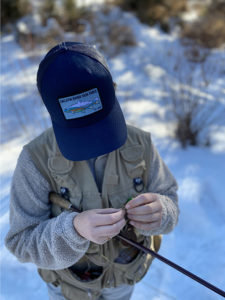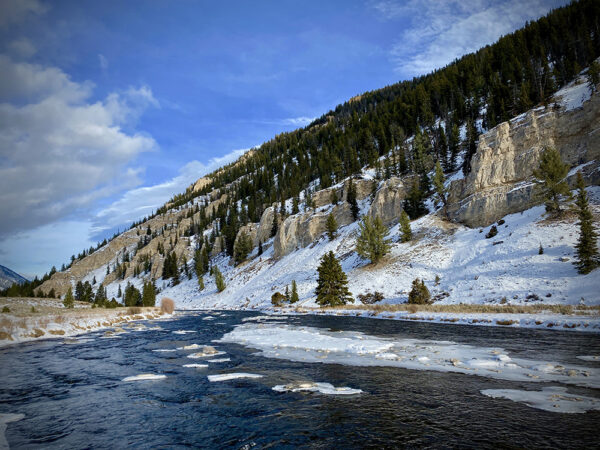So far, this season has been a mild one. While the Natural Resources Conservation Service is reporting a Gallatin watershed snowpack that’s 121 percent of normal, it didn’t feel much like winter until the last week of storms. Even with snowfall, temps have remained mild. For now, we can enjoy the warm temps and soak up some time on the river.
If the snow stops and our snowpack dips below average, we’re going to need a community effort to keep water in the river come August—plus, a warm spring can quickly melt even the deepest snowpack. With that in mind, there’s no time like the present to start planning for conservation. With Gallatin River Task Force’s indoor-amenities rebates and outdoor water-saving programs, we have you well positioned to make a difference, so this winter, enjoy the river, then plan on protecting it.
Here are just a few ways you can enjoy the river this time of year.
1. Go Fishing. Trout tend to mellow out in the winter, conserving energy in deep pools and rarely moving much in pursuit of food. With warmer temps, ice-free flows and sunny days, they’re more likely to be on the move. Check fishing reports and keep an eye out for warmer afternoons. These are your best bets for mid-winter action.

Mild days make for easier knot tying.
If cold-weather fishing isn’t your thing, check out the fly-tying nights at Gallatin River Guides. The shop hosts every Wednesday.
2. Take a Hike. Trails that are usually snowbound, like the Gallatin River trail between Storm Castle and 35 MPH bridge, are largely free of accumulation or at the very least, packed down enough to walk on comfortably. Ousel Falls is another creek-side trail that shouldn’t have much in the way of fresh powder, and it’s always popular with ski-season visitors. If you’re hiking Ousel, we suggest traction aids or trekking poles for stability.

The Ousel Falls hike has plenty of scenery.
3. Head Cross-Country. Groomed town trails follow along or nearby the forks of the Gallatin that flow through the Meadow Village. Take a few laps at lunch or after some turns at the resort. Once you’ve worked up an appetite, you’ll be in close proximity to several happy-hour specials.
There are also options along the river south of Big Sky before you enter Yellowstone National Park. If you’re dogless, follow the river to its source inside the Park for a real adventure, starting at the Bighorn Pass trailhead. Be sure to bring the camera along, watch for wildlife and even pack bear spray. It’s a common misconception that grizzlies den up all season long, but they’ve been known to get up and wander about, especially during warmer winters.

Water-skiing, Gallatin-style.
4. Make Some Home Improvements. Even if our snowpack stays at average, planning for a below-average year and leaving water supply in the watershed is a good thing. Do your part by upgrading your water-using appliances to more efficient models. The Task Force offers a rebate program that pays you cash for low-flow toilets, washers and showerheads, and that’s just indoors. There’s even more savings for irrigating efficiently.
5. Make a Friend. Later this spring, we’ll be launching our Trout-Friendly Landscaping program, the first of its kind in Montana. Participants will receive accreditation for reaching certain standards regarding their landscape management, and there are several money- and water-saving options to choose from. Stay tuned to our website for the program’s launch in March.
This blog originally appeared in the January 31 issue of Explore Big Sky.

